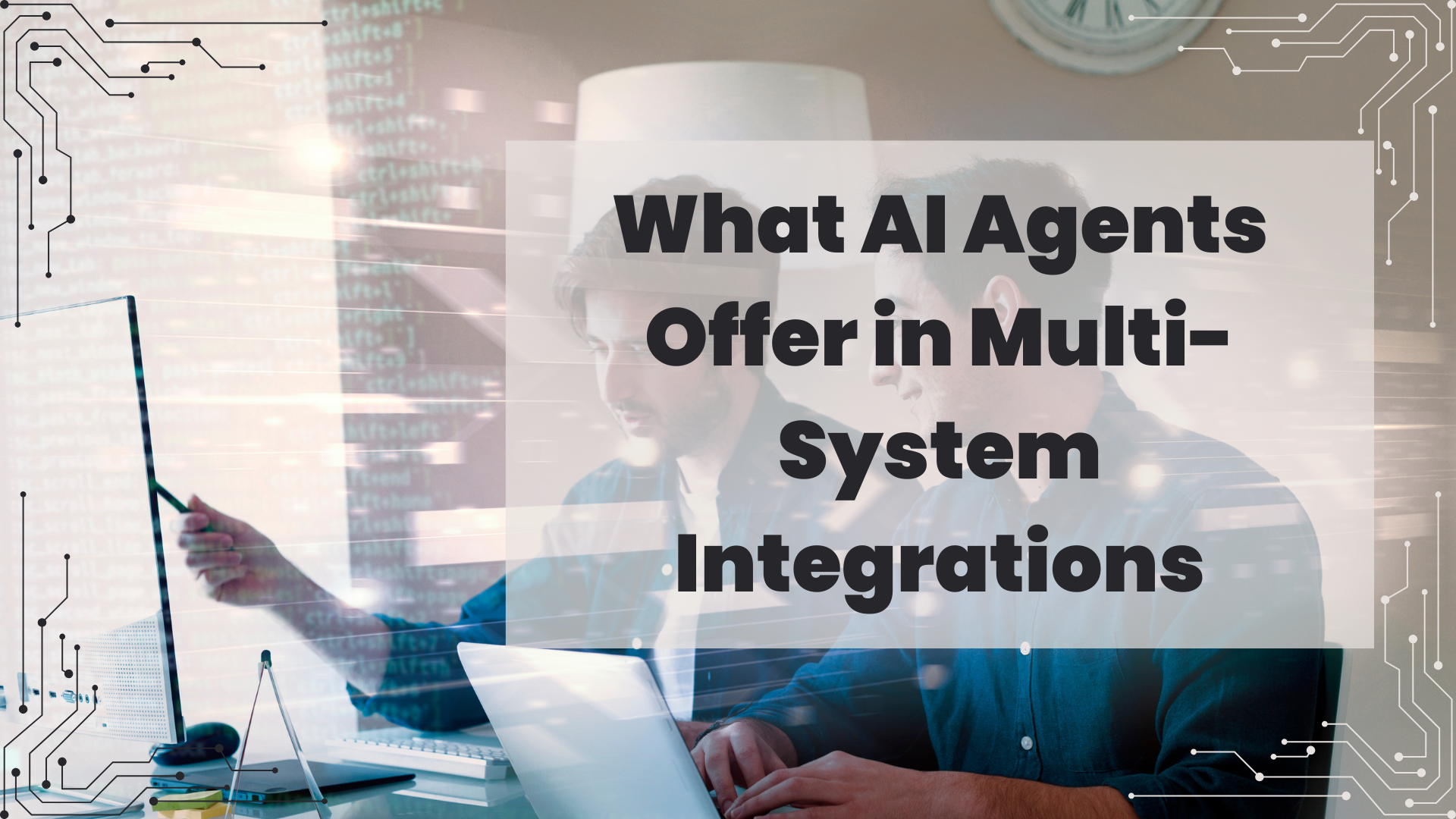What AI Agents Offer in Multi-System Integrations

For decades, enterprises have struggled with a familiar paradox: the more systems they deploy to improve efficiency, the less efficient their overall operations become. Every new CRM, ERP, or marketing automation platform promises integration but inevitably introduces friction — data silos, communication gaps, and coordination delays.
This is the quiet crisis of the modern digital enterprise: too much technology, too little connection.
Today, AI agents are emerging as the answer — not as another integration tool, but as autonomous orchestrators that understand, interact with, and optimize systems dynamically. They are changing the very nature of how multi-system environments communicate and evolve, bridging gaps that traditional APIs and middleware could never close.
Instead of coding connections between systems, AI agents interpret business logic, learn workflows, and collaborate across applications — enabling true interoperability that grows smarter with every interaction.
The Integration Challenge: Too Many Systems, Too Little Synergy
A Growing Problem
The average enterprise uses over 200 software applications, each solving a specific function — HR, finance, sales, analytics, operations. Yet, less than 30% of these systems communicate seamlessly with each other. The result? Data fragmentation, duplicated effort, and manual reconciliation.
Integration efforts often rely on point-to-point connections, custom APIs, or middleware layers. While these enable communication at a technical level, they lack the contextual understanding needed for end-to-end orchestration.
The Cost of Fragmentation
For executives, the cost of poor integration isn’t just operational — it’s strategic.
-
Decision-making lag: Inconsistent data across systems slows analysis and response.
-
Process inefficiency: Employees waste hours switching between platforms and reconciling data.
-
Customer experience degradation: Incomplete data journeys result in inconsistent service.
-
IT overload: Every new system integration becomes a resource-intensive project.
This isn’t a technology problem anymore; it’s a systems intelligence problem. And AI agents solve it not by connecting systems harder — but by connecting them smarter.
How AI Agents Redefine Multi-System Integration
AI agents don’t just integrate systems — they interpret them. They understand workflows, relationships, and dependencies, creating adaptive bridges between platforms that evolve autonomously.
From Integration Scripts to Intelligent Orchestration
Traditional integrations rely on rule-based workflows — “if X happens in System A, do Y in System B.” These rigid connections break whenever conditions change. AI agents replace that rigidity with contextual reasoning.
They learn how systems interact, detect anomalies, and make adjustments on the fly. Instead of waiting for IT to reconfigure connections, agents self-optimize integration logic in real time.
The Intelligence Layer
AI agents act as an intelligence layer sitting above enterprise systems, unifying them through understanding rather than syntax.
They can:
-
Interpret multiple data models and APIs
-
Translate semantics between platforms
-
Coordinate workflows across heterogeneous systems
-
Monitor performance and heal disruptions automatically
In doing so, they shift integration from a technical exercise to a strategic function — one that continuously evolves with the business.
The Architecture of AI-Driven System Integration
A multi-system environment integrated through AI agents typically follows five core architectural layers.
1. Data Comprehension Layer
Agents use AI-based data mapping to understand different schemas, fields, and terminologies across systems. Through semantic analysis, they align equivalent concepts automatically — e.g., “customer ID” in CRM vs. “client number” in ERP.
2. Context Recognition Layer
Agents analyze transactional and process context. They recognize why a data exchange is happening — a refund, a fulfillment update, a compliance event — and apply relevant logic dynamically.
3. Communication Layer
Using natural language processing (NLP) and API orchestration, AI agents translate intent between systems. They can adapt to API changes, manage versioning, and even generate new integration calls autonomously.
4. Decision Layer
Here, agents apply reinforcement learning and causal reasoning to make real-time decisions. If one system fails, they reroute data through alternate pathways or queue tasks until recovery.
5. Optimization Layer
Agents continuously assess data flow efficiency, latency, and accuracy — adjusting orchestration logic for maximum throughput and minimal redundancy.
This architecture enables living integrations — systems that evolve, repair, and optimize themselves without manual intervention.
Why Traditional Integration Tools Fall Short
1. Static Logic
Middleware and iPaaS platforms follow predefined workflows. They don’t understand business context or intent. AI agents, on the other hand, reason and adapt.
2. Limited Scalability
Adding new systems to traditional integrations requires reconfiguration. AI agents dynamically extend connections as new endpoints appear, using auto-discovery mechanisms.
3. Lack of Autonomy
Most integration tools still require human monitoring. AI agents self-heal and self-optimize — reducing IT workload and minimizing downtime.
4. Minimal Insight
While legacy integrations move data, they don’t extract insights. AI agents analyze data in transit, enabling real-time intelligence sharing across departments.
By addressing these limitations, AI agents turn integration into a strategic enabler rather than a maintenance burden.
What AI Agents Actually Offer in Multi-System Integrations
AI agents deliver tangible capabilities that go far beyond data synchronization.
1. Semantic Interoperability
They enable systems with different languages, formats, and taxonomies to “understand” each other. Agents interpret meaning, not just data fields — ensuring consistent context across systems.
2. Event-Driven Orchestration
Agents react to events autonomously — whether a new order, a customer complaint, or a supply chain delay — and coordinate actions across systems instantly.
3. Intelligent Error Recovery
When an integration fails, agents don’t just log errors. They diagnose the issue, identify root causes, and either retry or reroute operations automatically.
4. Predictive Coordination
By analyzing historical data, agents predict potential integration bottlenecks or data mismatches before they occur, proactively adjusting workflows.
5. Adaptive Compliance
Agents monitor compliance requirements across systems — from GDPR to internal audit trails — ensuring that data movement remains compliant in real time.
6. Knowledge Sharing Across Systems
Agents function as knowledge conduits, ensuring that when one system learns (e.g., customer sentiment trends), others can benefit immediately without manual updates.
These capabilities make integration not just more efficient — but intelligent and anticipatory.
The Business Impact: Integration as a Strategic Asset
For C-level leaders, the benefits of AI-driven multi-system integration go beyond IT efficiency. They reshape the operational DNA of the enterprise.
1. Unified Data Fabric
AI agents create a single source of contextual truth across departments. Executives can trust that decisions — from finance to operations — are informed by synchronized, real-time data.
2. Accelerated Decision Velocity
By eliminating data latency and reconciliation cycles, agents enable faster, evidence-based decision-making.
3. Reduced IT Overhead
With self-learning agents managing integrations, IT teams shift from maintenance to innovation — focusing on architecture and security rather than endless API patching.
4. Enhanced Agility
Enterprises can integrate new applications or external partners rapidly without months of coding — crucial in M&A, product launches, and digital transformations.
5. Improved Customer Experience
Seamless data flow between sales, support, and operations means customers interact with a coherent, informed organization — not disconnected departments.
When integration becomes intelligent, the entire business becomes fluid, responsive, and resilient.
The C-Suite Perspective: Turning Complexity into Control
Executives don’t need more tools; they need clarity and control. AI agents deliver exactly that.
For CEOs
They ensure the organization operates as a unified, adaptive organism — capable of scaling without chaos.
For CTOs
They provide a path to zero-friction architecture, where legacy and modern systems coexist seamlessly.
For CFOs
They reduce integration costs and downtime, improving cost efficiency and ROI.
For COOs
They increase operational visibility, enabling predictive coordination across functions.
For CIOs
They future-proof infrastructure — making the enterprise ready for continuous innovation without integration debt.
In short, AI agents transform integration from a technical nuisance into a competitive advantage.
Governance, Trust, and Security
As agents gain autonomy, governance becomes critical. Trust must be built into the system architecture.
Key Governance Mechanisms
-
Explainable Orchestration: Every AI-driven integration decision must be traceable.
-
Access Control: Agents operate within strict permission boundaries.
-
Auditability: Each data exchange is logged for compliance.
-
Ethical Parameters: Agents must respect organizational policies and privacy standards.
-
Continuous Oversight: Human supervisors monitor high-stakes workflows to ensure alignment with business objectives.
These measures ensure that intelligence doesn’t compromise integrity.
Implementation Roadmap for AI-Driven Multi-System Integration
Transitioning from manual integration to AI-agent-led orchestration requires a structured approach.
Phase 1: Assessment
-
Map existing systems and integration pain points.
-
Identify areas of redundancy, bottlenecks, and data inconsistency.
Phase 2: Infrastructure Preparation
-
Consolidate APIs and metadata repositories.
-
Ensure cloud or hybrid environments are ready for agent deployment.
Phase 3: Pilot Deployment
-
Begin with a small cluster of systems (e.g., CRM + ERP + BI).
-
Deploy a single orchestrator agent to learn data patterns and workflows.
Phase 4: Scaling and Collaboration
-
Introduce domain-specific agents for finance, operations, or marketing.
-
Enable inter-agent communication for cross-system coordination.
Phase 5: Optimization and Governance
-
Establish continuous learning cycles and monitoring dashboards.
-
Regularly audit decisions for performance and compliance.
This incremental roadmap ensures adoption without disruption — and visibility at every step.
Measuring Success: Integration Intelligence Metrics
Executives must move beyond traditional “uptime” metrics to evaluate success.
Core KPIs Include:
-
Integration Velocity: Time to onboard or connect a new system.
-
Data Consistency Rate: Percentage of harmonized records across systems.
-
Error Recovery Time: Average time for autonomous resolution.
-
System Synergy Index: Degree of coordination between systems post-integration.
-
Cognitive Uptime: Availability and responsiveness of AI agents.
These metrics redefine integration success from connectivity to coherence.
The Future: From Connected Systems to Cognitive Ecosystems
The next evolution isn’t just about connecting systems — it’s about creating cognitive ecosystems.
In these ecosystems:
-
AI agents communicate across enterprises, not just within them.
-
Integrations evolve based on business goals, not static configurations.
-
Systems anticipate each other’s needs — creating a web of proactive collaboration.
This is integration as intelligence, where software ceases to be a tool and becomes part of a shared cognitive fabric.
Conclusion
AI agents are dismantling one of the most persistent challenges in digital transformation — the friction of multi-system integration. They bring intelligence, adaptability, and autonomy to the enterprise ecosystem, enabling seamless coordination where traditional automation ends.
By implementing AI agent development solutions, organizations can transcend fragmented architectures and build intelligent ecosystems — where every system collaborates fluidly, learns continuously, and drives unified business outcomes.


